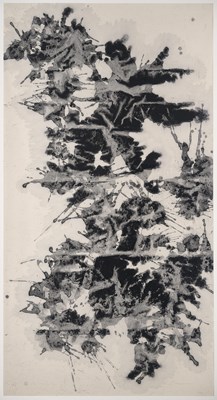14th May, 2024 11:30
Chinese and Japanese Works of Art
7
ZHANG DAWO (b.1943), OUT-BURST, SERIES 2022, 2000
ink on xuan paper, 96.5 by 180.3cm
Provenance:
The Origo Collection.
Michael Goedhuis
Published, Illustrated and Exhibited: Jason C Kuo, Chinese Ink Painting Now, New York, 2010, p.144, where the author notes that Zhang Dawoo was born in Beijing in 1943, and has been actively involved in the modern calligraphy movement. Coming from a cultivated family, Zhang had an unhappy childhood as his parents separated when he was three. In his early teens, Zhang lived in Tianjin with his father, who was a professor of English at Nankai University. During this period, Zhang studied with two master calligraphers, Li Henian and Wu Yuru, which built a solid technical platform for his later development. From 1963 to 1979, Zhang lived in the northeast of China, and the wild landscape he saw there greatly increased his appreciation of art stimulated by nature. After the Cultural Revolution, Zhang returned to Beijing in 1979; he began teaching calligraphy, and in the mid-1980s trying novel effects. In 1992 he set off for Tasmania, where his innovative calligraphic experiments developed. Since then Zhang Dawo has lived and worked in both Beijing and Australia. This led to his work being included in the pioneering exhibition of calligraphy organized by Gordon Barrass at the British Museum in 2002. The rugged landscape in Tasmania has become an endless inspiration for Zhang’s later works, in which he continues to explore the spatial arrangements and chromatic possibilities of Chinese calligraphy, attempting to render it relevant to modern viewers, wherever they’re from.
2000年 张大我(生于1943年),喷勃系列2022
Sold for £1,600
ink on xuan paper, 96.5 by 180.3cm
Provenance:
The Origo Collection.
Michael Goedhuis
Published, Illustrated and Exhibited: Jason C Kuo, Chinese Ink Painting Now, New York, 2010, p.144, where the author notes that Zhang Dawoo was born in Beijing in 1943, and has been actively involved in the modern calligraphy movement. Coming from a cultivated family, Zhang had an unhappy childhood as his parents separated when he was three. In his early teens, Zhang lived in Tianjin with his father, who was a professor of English at Nankai University. During this period, Zhang studied with two master calligraphers, Li Henian and Wu Yuru, which built a solid technical platform for his later development. From 1963 to 1979, Zhang lived in the northeast of China, and the wild landscape he saw there greatly increased his appreciation of art stimulated by nature. After the Cultural Revolution, Zhang returned to Beijing in 1979; he began teaching calligraphy, and in the mid-1980s trying novel effects. In 1992 he set off for Tasmania, where his innovative calligraphic experiments developed. Since then Zhang Dawo has lived and worked in both Beijing and Australia. This led to his work being included in the pioneering exhibition of calligraphy organized by Gordon Barrass at the British Museum in 2002. The rugged landscape in Tasmania has become an endless inspiration for Zhang’s later works, in which he continues to explore the spatial arrangements and chromatic possibilities of Chinese calligraphy, attempting to render it relevant to modern viewers, wherever they’re from.
Auction: Chinese and Japanese Works of Art, 14th May, 2024
Viewing
PUBLIC EXHIBITION
Friday 10 May 10:00pm - 7:00pm
Sunday 12th May 12:00pm - 4:00pm
Monday 13th May 10:00am - 5:00pm










